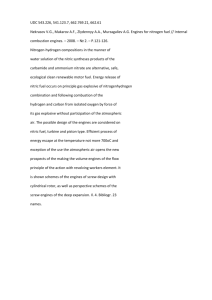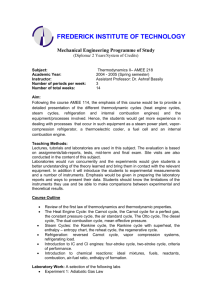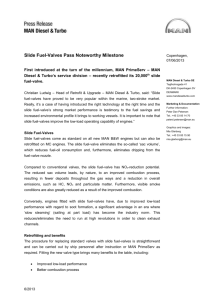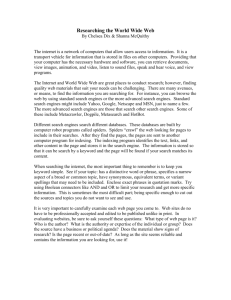GAS POWER CYCLES
advertisement
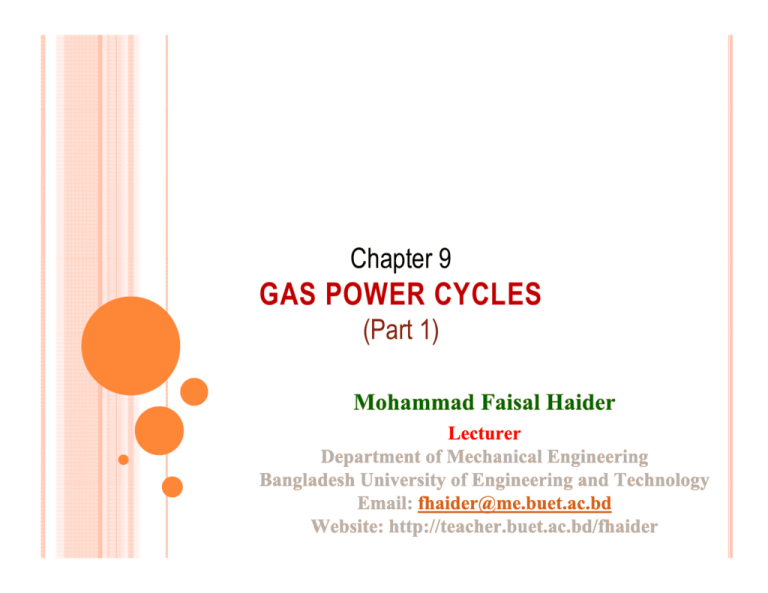
Chapter 9 GAS POWER CYCLES (Part 1) Chapter 9 GAS POWER CYCLES (Part 1a) Objectives j 1. Evaluate the performance of gas power cycles. 2 Develop simplifying assumptions applicable to gas power cycles. 2. cycles 3. Review the operation of reciprocating engines. 4 Analyze both closed and open gas power cycles. 4. cycles 5. Solve problems based on the Otto and Diesel cycles. 6. Solve pproblems based on the Brayton y cycle; y ; Brayton y cycle y with regeneration; g ; and Brayton cycle with intercooling, reheating, and regeneration. 7. Identify simplifying assumptions and perform second-law analysis on gas power cycles. cycles 3 Basic Considerations In Power Cycles Analysis Most power-producing devices operate on cycles. Ideal cycle: A cycle that resembles the actual cycle closely but is made up totally of internally reversible processes is called an ideal cycle. Recall: Thermal efficiencyy of heat engines g Reversible cycles such as Carnot cycle have the highest thermal efficiency of all heat engines operating between the same temperature levels. Unlike ideal cycles, they are totally reversible, and unsuitable as a realistic model. The analysis of many complex processes can be reduced to a manageable level by utilizing some idealizations. 4 Idealizations (simplifications) in the analysis of power cycles On a T-s diagram, the ratio of the area enclosed by the cyclic curve to the area under the heat-addition process curve represents the thermal efficiency of the cycle. 1. The cycle does not involve any friction. Therefore, the working fluid does not experience any pressure drop as it flows in pipes or heat exchangers. 2. All expansion and compression processes take place in a quasi-equilibrium manner. 3. The pipes connecting the various components of a system are well insulated, so heat transfer through them is negligible. Care should be exercised in the interpretation of the results from ideal cycles. On both P-v and T-s diagrams, the area enclosed by the process curve represents the net work of the cycle. 5 Carnot Cycle - Its Value In Engineering The Carnot cycle is composed of 4 totally reversible processes: isothermal heat addition, isentropic expansion, isothermal heat rejection, and isentropic compression. For both ideal and actual cycles: Thermal efficiency increases with an increase in the average temperature at which heat is supplied to the system or with a decrease in the average temperature at which heat is rejected from the system. P-v and T-s diagrams of a Carnot cycle. Example: A steady-flow Carnot engine. 6 Air-standard Assumptions The combustion process is replaced by a heat-addition process in ideal cycles. 1 Th 1. The working ki flfluid id is i air, i which hi h continuously ti l circulates in a closed loop and always behaves as an ideal gas. 2 All th 2. the processes th thatt make k up th the cycle l are internally reversible. 3. The combustion process is replaced by a h t dditi process from heat-addition f an external t l source. 4. The exhaust process is replaced by a h t j ti process that heat-rejection th t restores t the th working fluid to its initial state. Cold-air-standard assumptions: When the working fluid is considered to be air with constant specific heats at room temperature (25°C). Air-standard Air standard cycle: A cycle for which the air-standard air standard assumptions are applicable. 7 Chapter 9 GAS POWER CYCLES (Part 1b) Overview of Reciprocating Engines The reciprocating engine (basically a piston–cylinder device) is an invention that has proved to be very versatile and has a wide range of applications. Reciprocating engine is the powerhouse h off the th vastt majority j it off automobiles, trucks, light aircraft, ships, electric power generators, and many other devices. devices 9 Basic Components The piston Th i t reciprocates i t in i the th cylinder li d between b t t fixed two fi d positions iti called ll d the th top t dead d d centre (TDC) - the position that forms the smallest volume in the cylinder - and the bottom dead centre (BDC) - position that forms the largest volume in the cylinder. The distance between TDC and BDC is called the stroke of the engine. The diameter of the piston is called the bore. Compression ratio: 10 Performance Characteristics Net work output per cycle: Mean effective pressure (MEP): A fictitious pressure that, if it is acted on the piston during the entire power stroke, stroke would produce the same amount of net work as that produced during the actual cycle. Classifications of IC Engines: 1. Spark-ignition (SI) or Petrol engines 2. Compression-ignition (CI) or Diesel engines 11 Otto Cycle: Ideal Spark-Ignition Engines Cycle The piston executes four complete strokes within the cylinder. cylinder The crankshaft completes two revolutions for each thermodynamic cycle. These engines are called four-stroke IC engines. 12 Actual and ideal cycles in spark-ignition engines on a P-v diagram. T-s Diagram of Ideal Otto Cycle IC Engines Classifications: Four-stroke F t k cycle l 1 cycle = 4 stroke = 2 revolutions of crankshaft Two-stroke cycle 1 cycle = 2 stroke = 1 revolution of crankshaft Sequence of processes: 13 Two-Stroke IC Engines IIn two-stroke t t k engines, i allll four f f ti functions d described ib d earlier li are executed t d in i two t strokes: the power and compression stroke. Generally less efficient, but are relatively simple and inexpensive. They have high power-to-weight t i ht andd power-to-volume t l ratios. ti 14 Thermal Efficiency of Otto Cycle The heat supplied to the working fluid during constant-volume heating (combustion), The heat rejected from the working fluid during constant-volume cooling (exhaust), Temperature-volume p relation,, Thermal efficiency, Cold-air standard assumption. Compression ratio, 15 Engine Knock (Autoignition) Premature ignition of the fuel produces audible noise called engine knock. It hurts performance and causes engine damage. Autoignition places upper limit on compression ratios that can be used in SI engines. S ifi heat Specific h t ratio, ti k affects ff t the th thermal th l efficiency ffi i off the th Otto Ott cycle. l 16 Chapter 9 GAS POWER CYCLES (Part 1c) Diesel Cycle: Ideal Cycle for CI Engines In diesel engines, only air is compressed during the compression stroke, eliminating the possibility of autoignition. These engines can be designed to operate at higher compression ratios, typically between 12 and 24. Fuels that are less refined (thus less expensive) can be used in diesel engines. The combustion Th b ti process takes t k place l over a longer interval - fuel injection starts when the piston approaches TDC and continues duringg the first ppart of ppower stroke. Hence, combustion process in the ideal Diesel cycle is approximated as a constantpressure heat-addition process. 18 Sequence Seque ce of o processes: p ocesses 1-2 Isentropic compression 2-3 Constant-pressure heat addition 3 4 Isentropic 3-4 I t i expansion i 4-1 Constant-volume heat rejection. Note: Petrol and diesel engines differ only in the manner the heat addition (or combustion) process takes t k place. l It is approximated as a constant volume process in the petrol engine cycle and as a constant pressure process in the Diesel engine cycle. 19 Thermal Efficiency of Diesel Cycle Heat supplied to the working fluid during the constant-pressure heating (combustion), Heat rejected from the working fluid during the constant-volume t t l cooling li ((exhaust), h t) Th Thermal l efficiency ffi i off Di Diesell cycle l ((general), l) - constant specific heats Cutoff ratio, 20 For the same compression ratio, thermal efficiency of Otto cycle is greater than that of the Diesel cycle. cycle As the cutoff ratio decreases, the thermal efficiency of the Diesel cycle increases. increases Thermal efficiencies of large diesel engines range from about 35 to 40 percent. When rc =1, the efficiencies of the Otto and Diesel cycles are identical. Higher efficiency and lower fuel costs make diesel engines attractive in applications such as in locomotive engines, engines emergency power generation units, large ships, and heavy trucks. 21 Dual Cycle: Realistic Ideal Cycle for CI Engines Approximating the combustion process as a constant-volume or a constant-pressure heat addition process is overly simplistic heat-addition and not quite realistic. A better approach would be to model the combustion process in both SI and CI engines as a combination of two heattransfer processes, one at constant volume and the other at constant pressure. pressure The ideal cycle based on this concept is called the dual cycle. Note: Both the Otto and the Diesel cycles can be obtained as special cases of the dual cycle. 22

